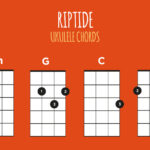Guitar tablature, affectionately known as “guitar tabs,” is a revolutionary system that has made learning guitar accessible to millions. Ditch the complexities of traditional music notation and dive straight into playing your favorite songs. Guitar tabs are designed to be intuitive, visually representing the guitar fretboard and guiding your fingers to the right positions. While sharing some similarities with standard notation in conveying rhythm and techniques, Guitar Tabs On Guitar offer a distinct advantage: they show you exactly where to place your fingers on the fretboard to produce specific notes.
This direct approach is incredibly beneficial because the guitar is unique in that the same note can be played in multiple locations across the fretboard. For beginners, this can be overwhelming in standard notation, but guitar tabs simplify this by removing the guesswork. Learning to read and use guitar tabs on guitar empowers aspiring guitarists to learn songs quickly, making it possible to play music without prior knowledge of musical notation.
At guitarplayers.net, we believe in making guitar learning enjoyable and efficient. That’s why we champion guitar tabs on guitar as a core tool for beginners. Tabs clearly illustrate both chords and individual notes, offering the fastest and most user-friendly path to mastering your favorite tunes. You don’t need any prior musical theory – just a guitar and the willingness to learn the simple visual language of tabs.
Ready to embark on your guitar journey and discover the power of guitar tabs on guitar? Let’s explore what guitar tabs are, how they work, and how they can unlock a world of musical possibilities for you.
Decoding Guitar Tabs: A Visual Song Map for Your Guitar
Guitar tablature is essentially a visual representation of music tailored specifically for guitar. Think of it as a roadmap for your fingers on the fretboard. A standard guitar tab is composed of six horizontal lines, each corresponding to one of the six strings on your guitar. When you look at a guitar tab, imagine you’re looking down at your guitar in playing position. The top line represents the high E string (the thinnest string), and descending lines represent the B, G, D, A, and low E strings (the thickest string) respectively. This familiar orientation makes learning guitar tabs on guitar incredibly intuitive.
Consider guitar tabs as your personal guide to learning songs quickly and efficiently. They bypass the need to memorize complex musical symbols and directly show you where to play.
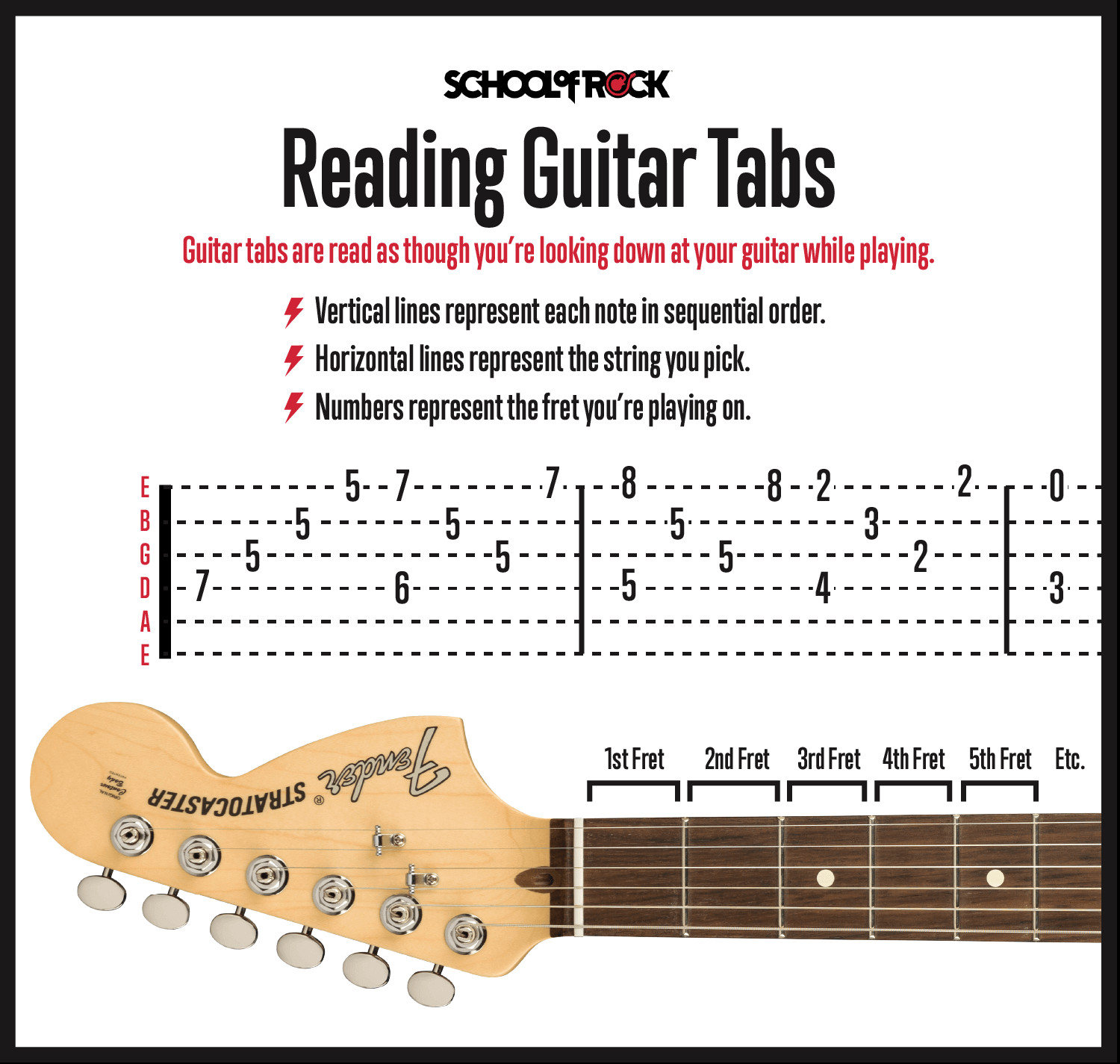 Guitar Tab Lines Representing Guitar Strings
Guitar Tab Lines Representing Guitar Strings
On these lines, you’ll see numbers. These numbers are your fret markers, indicating which fret on the guitar neck you need to press down. Frets are the metal strips running perpendicular to the strings along the fretboard, numbered 0-24 (or more on some guitars), starting from the nut (closest to the headstock).
A “0” on a string line in a guitar tab means play that string “open,” meaning you pluck or pick the string without pressing down any fret. A “1” indicates playing the note at the first fret, “2” at the second fret, and so on. Understanding this simple numbering system is fundamental to learning how to read guitar tabs on guitar. Remember, each number directly correlates to a fret number, making it a straightforward system for beginners.
Reading Guitar Tabs: Left to Right, Note by Note
Guitar tabs are read in a linear fashion, from left to right, just like reading text. The notes displayed in the tab are presented in the order they appear in the song. This chronological representation makes it easy to follow the musical progression.
When you encounter numbers stacked vertically across multiple lines in a guitar tab, it signifies a chord. A chord is formed by playing multiple notes simultaneously. In tabs, these vertically aligned numbers indicate the frets to be pressed on different strings, and you strum all these indicated strings together to play the chord. Guitar tabs on guitar are particularly advantageous for learning chords as they clearly show you the finger positions, unlike standard notation which requires prior chord knowledge.
Essential Knowledge for Reading Guitar Tabs on Guitar
To effectively read guitar tabs on guitar, beginners should first become familiar with the names and order of the six guitar strings (E, A, D, G, B, e from thickest to thinnest) and the location of frets on the fretboard. This basic understanding will enable you to quickly locate the correct strings and frets indicated in the tab. Practice visualizing the tab in relation to your guitar fretboard to enhance your reading speed and accuracy.
The Guitar Tab Staff: Strings Instead of Notes
The guitar tab staff may visually resemble the staff used in standard music notation, but there’s a crucial difference. In standard notation, the lines of the staff represent musical pitches. In guitar tabs, however, the six lines represent the six guitar strings.
The top line is always the high E string, and the bottom line is the low E string. This direct string-to-line correspondence makes learning how to read guitar tabs on guitar significantly easier and more intuitive, especially for visual learners. Typically, guitar tabs are labeled “TAB” clearly to avoid confusion with standard musical notation.
Understanding Guitar Frets: The Building Blocks of Notes
Guitar frets are the metal strips that are embedded in the fretboard of your guitar. They are the markers that delineate musical notes. Most guitars come with anywhere from 19 to 24 frets. Each fret represents a semitone or half step in musical pitch. Moving from one fret to the next changes the pitch by a half step. Within an octave, there are 12 semitones (or frets).
To help navigate the fretboard, most guitars feature fret markers, often dots or inlays, at specific fret positions like the 3rd, 5th, 7th, 9th, and 12th frets. These markers are visual aids to help you quickly identify fret positions while playing and reading guitar tabs on guitar.
Remember, in guitar tabs on guitar, numbers represent fretted notes, and the number “0” represents an open string. An open string is played without pressing down any fret – you simply pick or pluck the string to produce a sound.
Guitar Tab Chords: Vertical Harmony in Tabs
Guitar chords in tabs don’t have special symbols, but they are easily identifiable by their vertical arrangement. When you see multiple numbers aligned vertically in a guitar tab, it indicates a chord. These notes are intended to be played simultaneously, creating harmonic richness. Even if a chord is arpeggiated (played one note at a time), it may still be represented in tab format as individual notes, even though you are still fretting the chord shape.
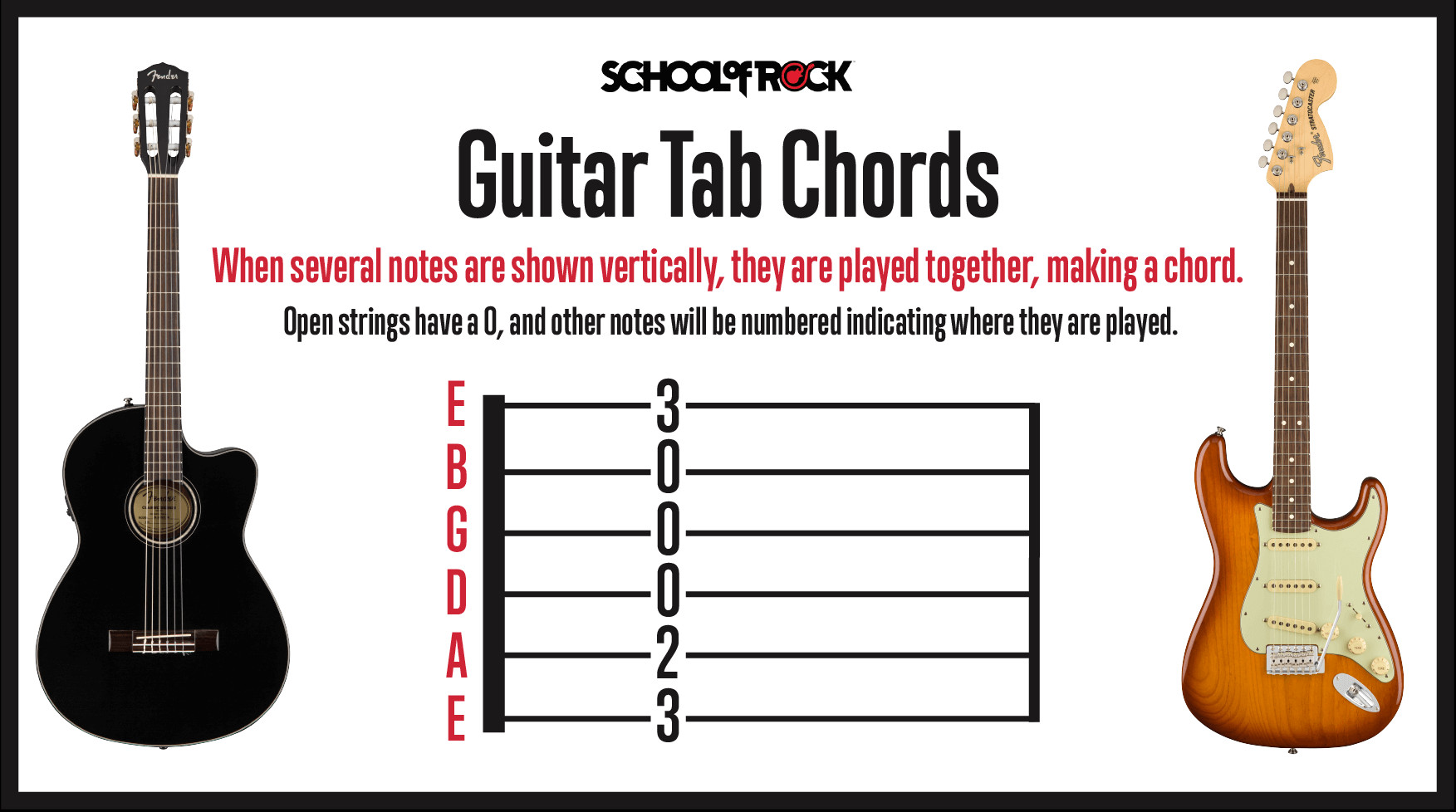 Guitar Tab Chords Example
Guitar Tab Chords Example
Guitar Tab Riffs: Iconic Musical Phrases in Tab Form
Many rock, blues, and popular songs are built around “riffs” – short, repeated musical phrases that often define a song’s character. Riffs typically combine single notes and partial chords, like power chords. When reading guitar tabs on guitar for riffs, the same principles apply: vertically aligned notes are played together. This clarity makes learning iconic riffs from your favorite songs accessible and enjoyable.
Guitar Tabs vs. Chord Charts: Understanding the Differences
While both guitar tabs and chord charts are tools for guitarists, they serve slightly different purposes. A chord chart is a diagram that visually shows you where to place your fingers on the fretboard to form a specific chord. It often also includes finger numbers to guide your finger placement. Chord charts are frequently placed above song lyrics to indicate chord changes within a song’s structure.
Chord charts primarily display the root notes that constitute a chord, usually 3-4 unique notes. However, a complete song arrangement often involves more than just basic chords. It might include single notes, notes outside the basic chord structure, or arpeggios. Guitar tabs on guitar offer a more comprehensive view, capturing these nuances that chord charts might miss. For this reason, chord charts are often used in conjunction with guitar tabs, especially for beginners, to provide a simplified starting point before diving into the full detail of the tab.
Fingers and Numbers: Tab Numbers Represent Frets, Not Fingers
Guitar tablature is linear and fret-focused, while chord charts are like a snapshot of the fretboard from a player’s perspective. Chord charts often use a numbering system to indicate which finger to use for each note in a chord. Typically, the index finger is 1, middle finger is 2, ring finger is 3, and pinky finger is 4.
It’s crucial to note that in guitar tabs on guitar, the numbers represent the fret number to be played, not which finger to use. Finger suggestions are generally omitted in tabs to allow for flexibility and personal playing styles. However, easy guitar tabs may sometimes incorporate chord charts to guide beginners on hand positioning and finger placement for basic chords.
Play Guitar Live: From Tabs to Stage Performances
Our approach at guitarplayers.net goes beyond just learning tabs. We aim to empower you to perform. Our resources and lessons are designed by experienced musicians to provide you with the skills you need to confidently play guitar. Imagine moving from learning guitar tabs on guitar to performing live shows, developing your musicality in a supportive environment, no matter your current skill level.
Explore Guitar Lessons at GuitarPlayers.net!
Guitar Tab Symbols: Beyond Numbers and Lines
Beyond the basic lines and numbers, guitar tabs utilize a range of symbols to indicate specific playing techniques. Mastering these symbols is crucial for accurately interpreting tabs and making your playing sound authentic. Understanding these symbols in guitar tabs on guitar will significantly enhance your ability to learn and play songs as intended.
Before you start playing with tabs, always ensure your guitar is properly tuned. Incorrect tuning will make even perfectly read tabs sound wrong. Refer to our Guitar Tuning Guide for assistance.
Muting Guitar Notes: Adding Dynamics and Texture
Muting is a vital technique in many genres, particularly rock, metal, punk, and alternative music. Different muting techniques add rhythmic drive, percussive elements, and dynamic variation to your playing.
How to Mute Guitar Notes Effectively
Muting can be achieved with either your picking hand, your fretting hand, or a combination of both. Often, guitarists use muting instinctively without consciously thinking about it, especially when playing at louder volumes to eliminate unwanted string noise and feedback. In song arrangements, muting can be used to create contrast, for example, muting verses while leaving choruses unmuted for a dynamic shift.
Guitar Technique: Palm Muting – The Rock Guitar Staple
Palm muting is a cornerstone technique in rock guitar. It involves resting the palm of your picking hand lightly on the strings near the bridge while picking. The pressure applied by your palm affects the degree of muting. Heavy palm muting produces a tight, percussive, chugging sound, while lighter palm muting allows more of the note’s sustain to ring through. In guitar tabs on guitar, palm muting is usually indicated by “P.M.” written above the section of the tab where it should be applied.
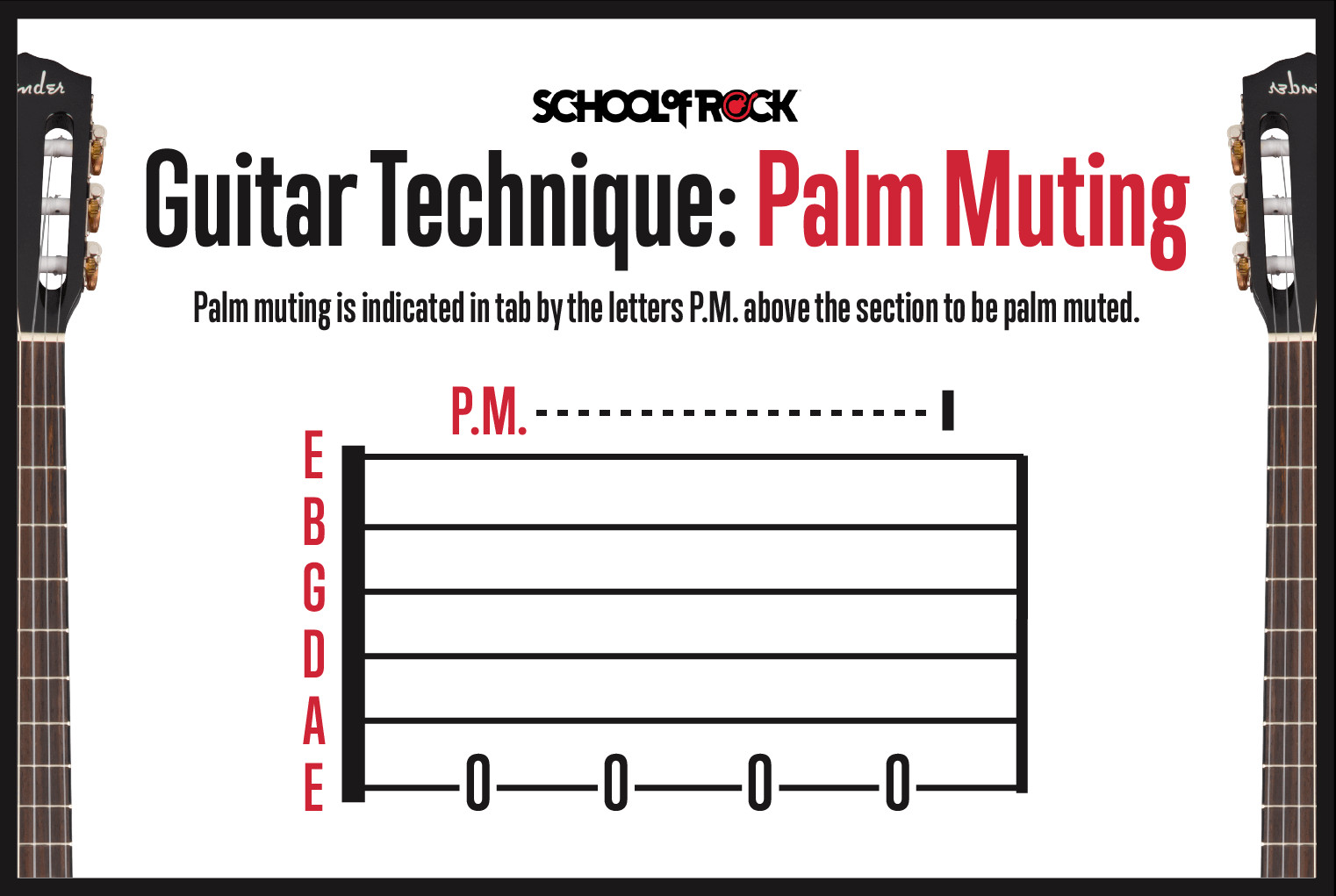 Guitar Palm Muting Technique
Guitar Palm Muting Technique
Guitar Technique: Muted Notes – Fretting Hand Muting
Muted notes are distinct from palm muting and are achieved using the fretting hand. In this technique, you pick the notes as indicated in the guitar tab on guitar, but your fretting hand only lightly touches the strings without fully pressing them down to the fretboard. This produces a percussive, scratchy sound rather than a clear pitch. In guitar tabs, muted notes are typically represented by an “X” in place of a fret number.
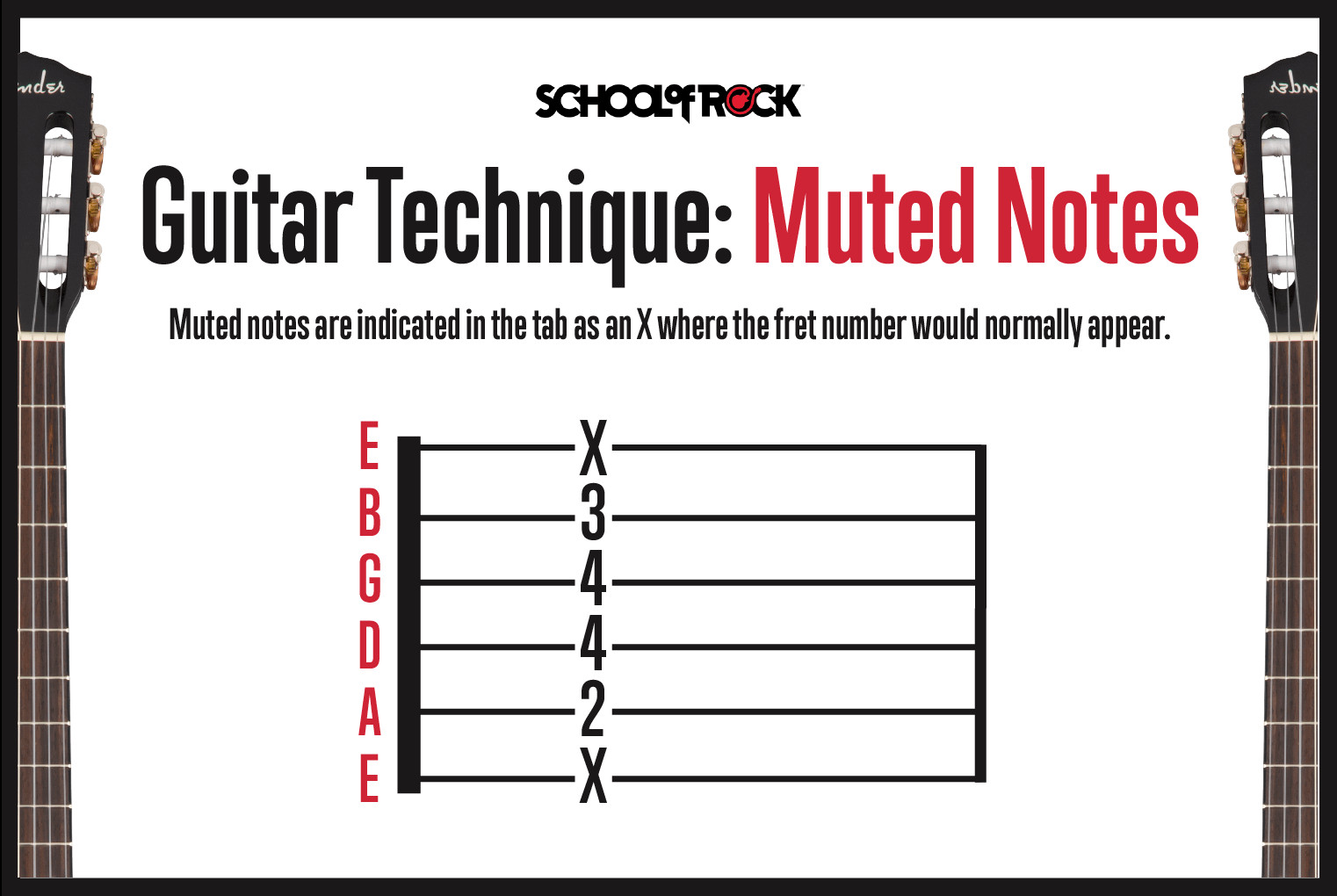 Guitar Fretting Hand Muting Technique
Guitar Fretting Hand Muting Technique
Bending Guitar Strings: Adding Vocal Expression
String bending is a technique that injects expressive, vocal-like qualities into guitar playing. In guitar tabs on guitar, bends are indicated by a curved arrow above the note to be bent. The arrow usually includes an indication of the bend’s extent, such as “½” for a half step bend (one fret higher) or “full” for a full step bend (two frets higher). These target pitches are often referred to as “target notes.”
Mastering String Bending Technique
String bending involves pushing or pulling the string sideways across the fretboard, rather than just pressing down vertically. For most strings (except the low E), you generally push upwards towards the ceiling. The low E string is typically bent downwards towards the floor. The key to smooth bending is applying even, consistent pressure throughout the bend.
Guitar Technique: Standard String Bending
Most string bends are executed using a combination of fingers for strength and control. Typically, the “main” fretting finger (often the ring finger) is used to bend the string, while the middle and index fingers provide support and stability. This multi-finger approach makes bending smoother, easier to control, and helps achieve accurate pitch.
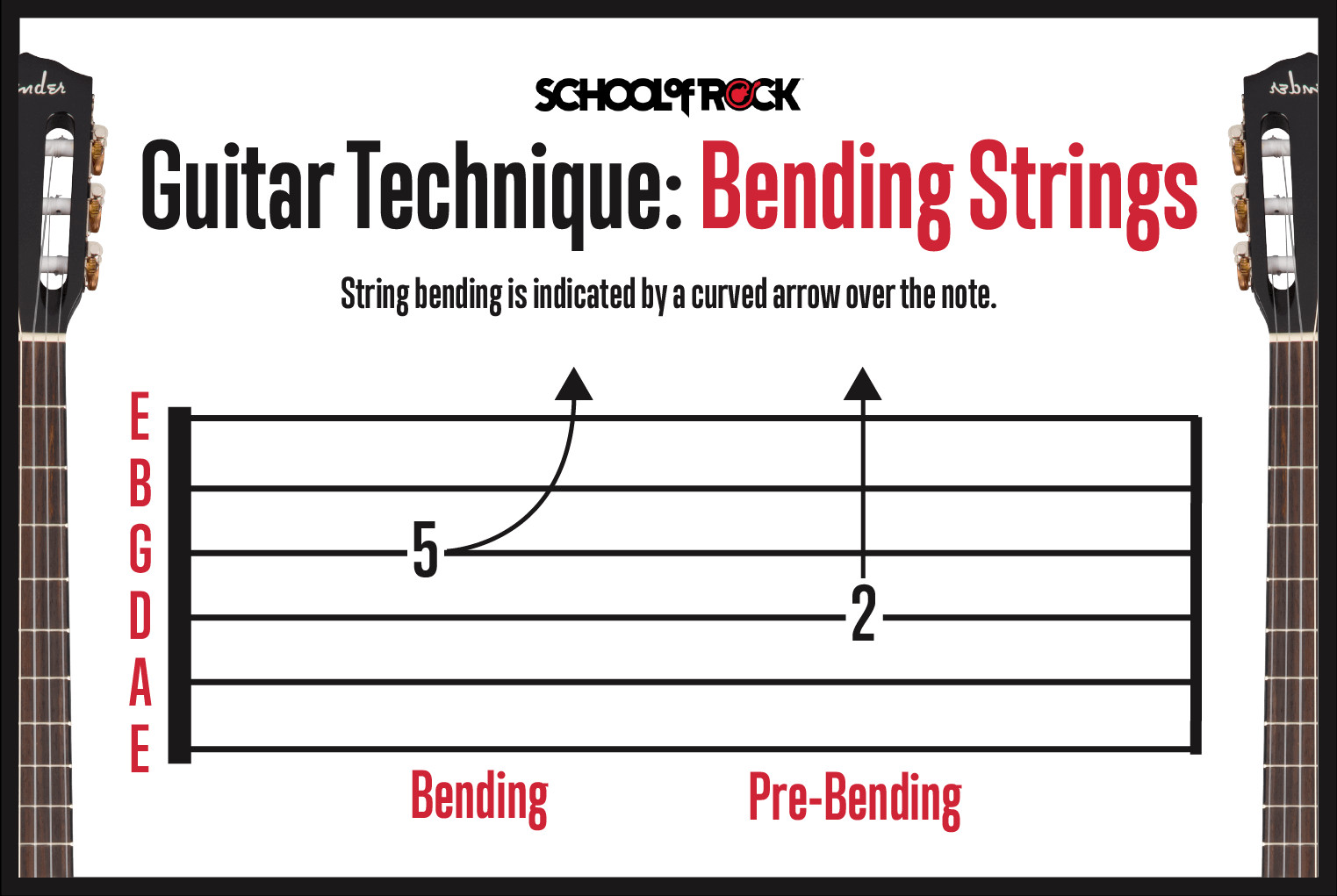 Guitar String Bending Technique
Guitar String Bending Technique
Guitar Technique: Pre-bending Guitar Strings
Another bending variation you might encounter in guitar tabs on guitar is the “pre-bend.” In a pre-bend, you bend the string before picking it. The tab notation for a pre-bend typically includes a vertical arrow indicating the bend amount (full, ½, etc.) followed by a curved arrow downwards, indicating the release of the bend back to the original pitch after picking. Pre-bends can resolve back to the original note or bend further upwards to another target note, adding a unique expressive dimension.
Sliding Guitar Notes: Smooth Transitions Between Frets
Sliding is another essential technique that allows for smooth transitions between notes. You can slide up to a higher note or down to a lower note. Sliding differs from bending because you maintain contact with the string while moving your fretting finger along the fretboard to the target fret.
Guitar Technique: Slide Up
In guitar tabs on guitar, a slide up is represented by a line connecting the note you are sliding from to the note you are sliding to. If the target note is higher in pitch, the line may slant slightly upwards.
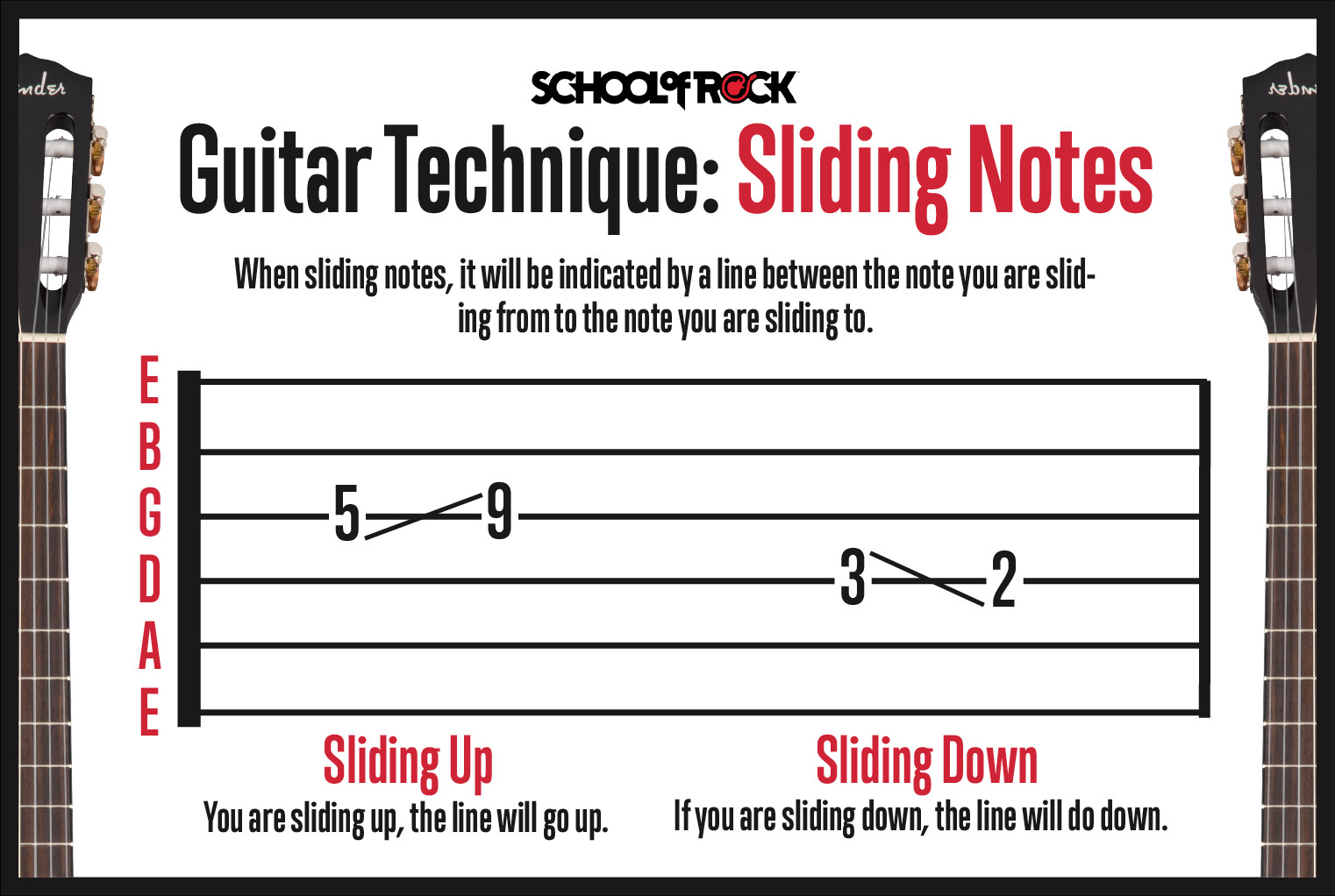 Guitar Slide Up Technique
Guitar Slide Up Technique
Guitar Technique: Slide Down
Conversely, a slide down in guitar tabs on guitar is also represented by a line between the starting and ending notes. If the target note is lower in pitch, the line may slant slightly downwards.
Hammer-ons: Creating Notes Without Picking
The hammer-on is a technique where you produce a note by “hammering” down on the string with a fretting finger, without picking the string. You can hammer-on from an open string or from a previously fretted note, and the resulting note will always be higher in pitch. In guitar tabs on guitar, hammer-ons are indicated by the letter “H” and a curved line (arc) connecting the initial note (open or fretted) to the hammered-on note.
How to Execute Hammer-ons Effectively
To perform a hammer-on, strike the string sharply with your fretting finger with enough force to make the note sound clearly. This requires practice to achieve a clean, strong tone. Hammer-ons are generally easier to execute on electric guitars, especially at higher volumes. Start practicing on the open low E string by hammering onto the third fret, and let the note ring. Repeat this exercise on different strings and frets.
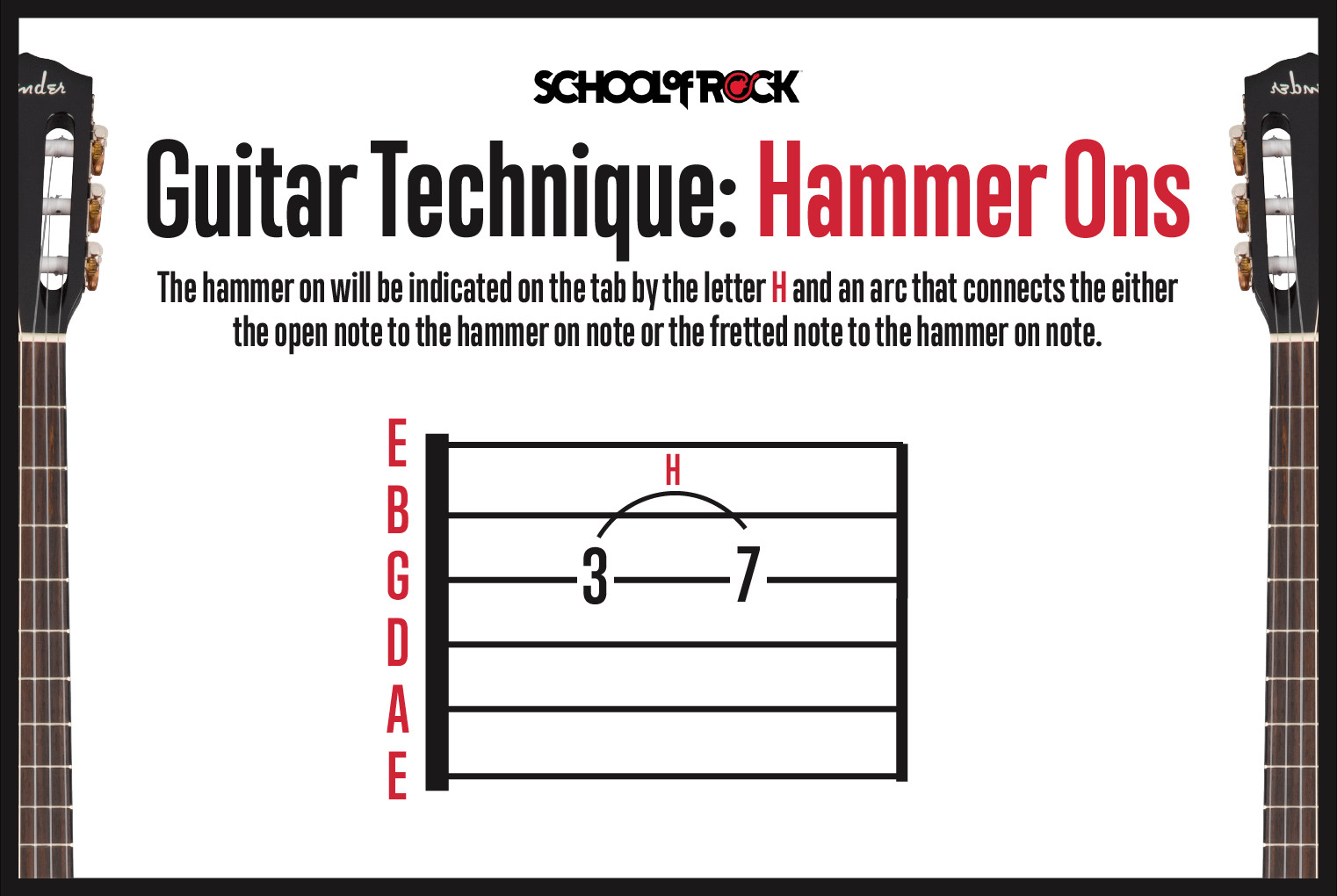 Guitar Hammer-on Technique
Guitar Hammer-on Technique
Pull-offs: Releasing to a Lower Note
Pull-offs are the opposite of hammer-ons. Instead of hammering on, you “pull off” a fretted string to sound either an open string or a lower fretted note. In guitar tabs on guitar, pull-offs are represented by the letter “P” and an arc connecting the pulled-off note to the resulting lower note (open or fretted). The resulting note will always be lower in pitch than the initial note.
How to Execute Pull-offs Effectively
To execute a pull-off, fret a note, and then pull your finger off the string in a sideways and slightly downward motion, plucking the string just enough to make the lower note sound. You need to “grab” enough of the string with your fingertip as you pull off to produce a clear tone.
Hammer-ons and pull-offs can be combined in alternation to create rapid note sequences, sometimes referred to as “trills.”
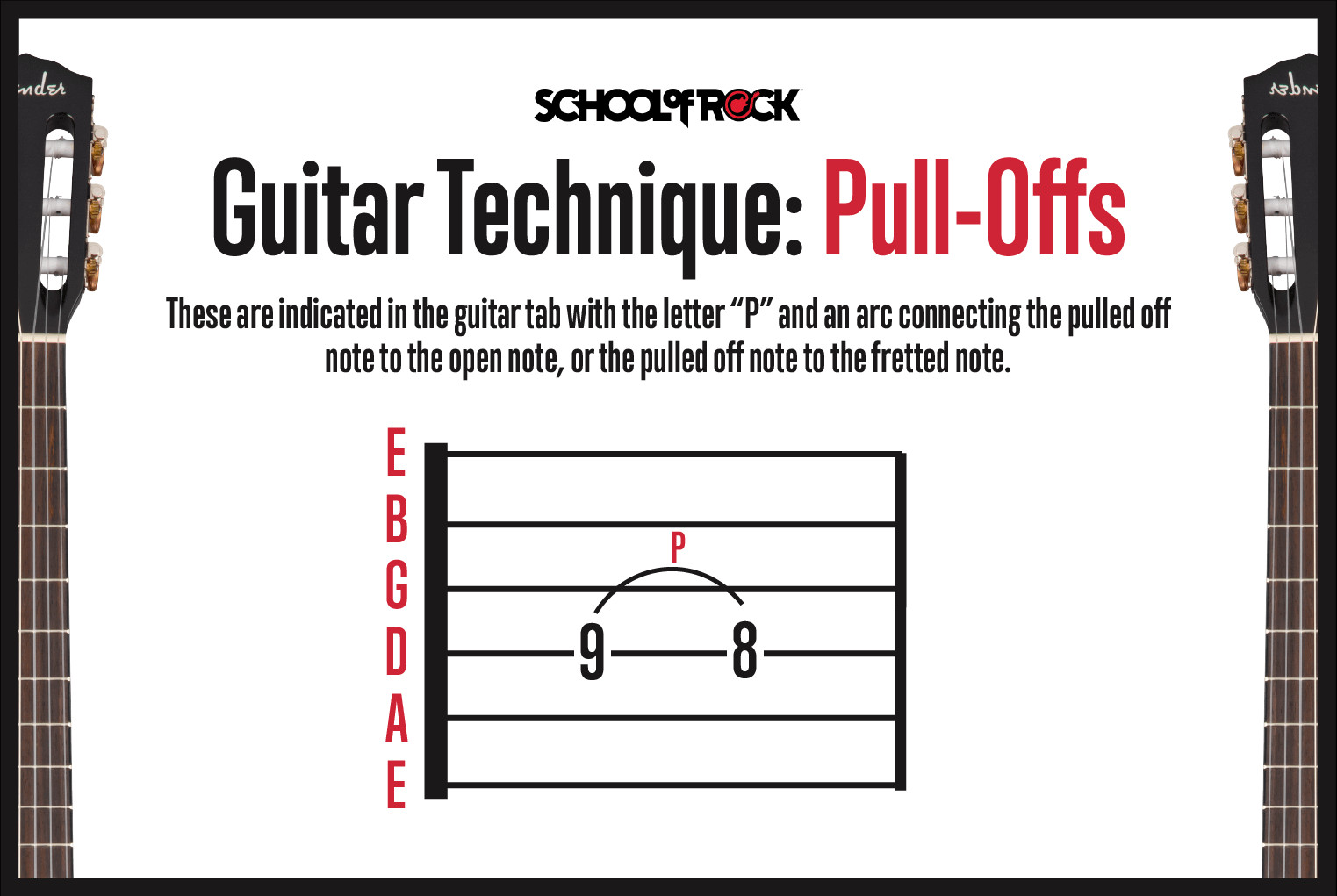 Guitar Pull-off Technique
Guitar Pull-off Technique
Vibrato: Adding Expressive Note Modulation
Vibrato is a technique that adds warmth and expressiveness to notes by subtly and rapidly varying the pitch up and down around the original note. In guitar tabs on guitar, vibrato is represented by a zig-zag line above the staff. The length of the zig-zag line generally indicates the duration of the vibrato. Longer lines suggest a longer vibrato application.
Mastering Vibrato Technique
Vibrato is similar to bending but with a much smaller pitch variation. You can apply vibrato using a single finger or by using a main finger supported by others. Start by practicing a smooth, slow vibrato and gradually vary the speed for different expressive effects. Like bending, vibrato is a highly personal technique, and each guitarist develops a unique vibrato style.
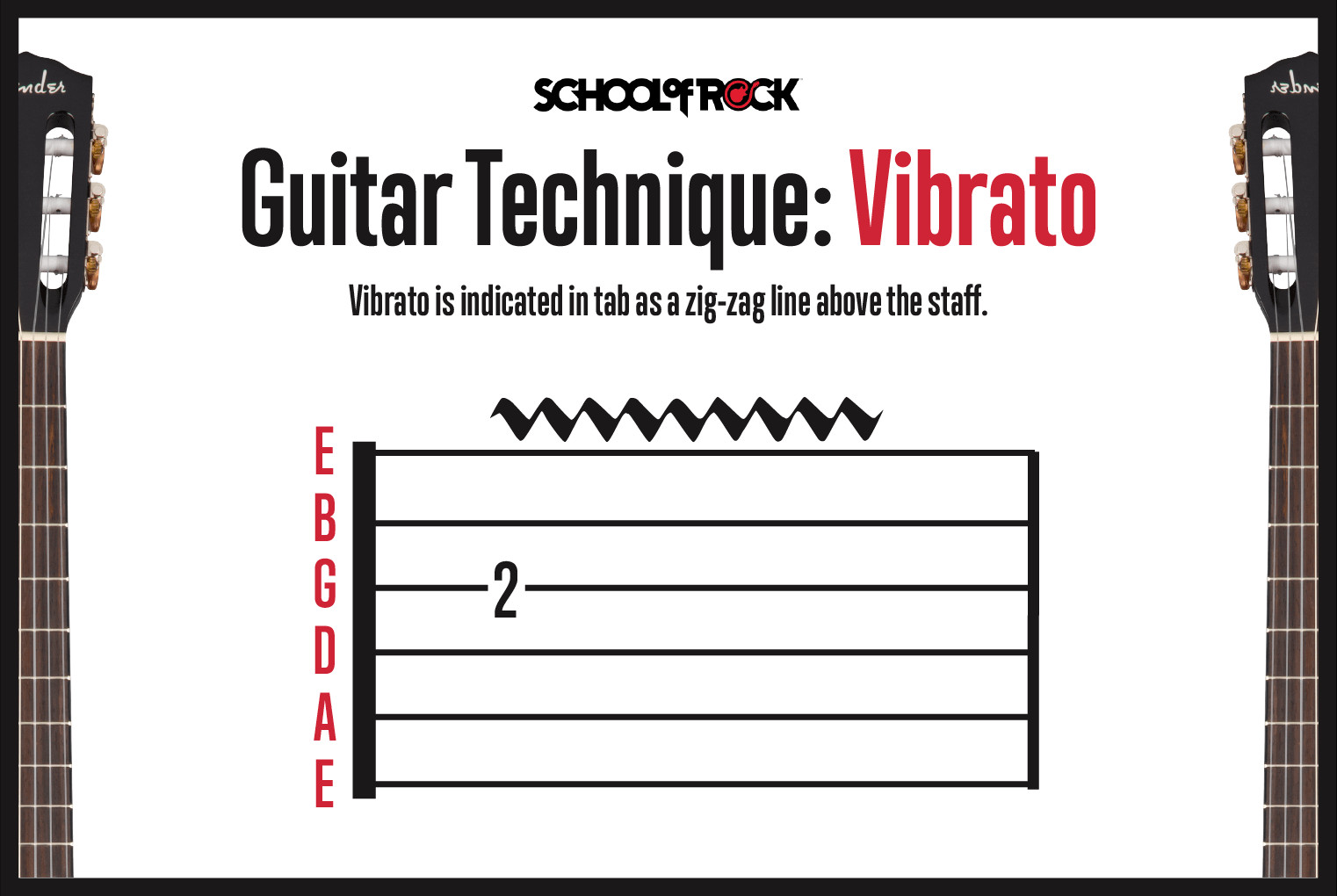 Guitar Vibrato Technique
Guitar Vibrato Technique
Tapping: Two-Handed Fretboard Exploration
Tapping is a technique that expands the guitar’s range and speed by using both hands to fret notes on the fretboard. It involves using your picking hand’s index finger to “tap” or hammer-on notes on the fretboard, in addition to your regular fretting hand. The tapping motion is essentially a variation of a hammer-on. In guitar tabs on guitar, tapping is indicated by the letter “T” above the tapped note.
How to Finger Tap on Guitar
Tapping gained widespread popularity thanks to Eddie Van Halen, although the technique has roots in classical guitar. To finger tap, fret a note with your fretting hand as usual, and then use the index finger of your picking hand to sharply tap a higher fret on the same string.
Tapping is similar to a hammer-on, but uses your picking hand instead of your fretting hand. This allows you to play notes with wider intervals and at faster speeds than possible with traditional fretting hand techniques alone. Playing with overdrive or distortion enhances the sustain and clarity of tapped notes.
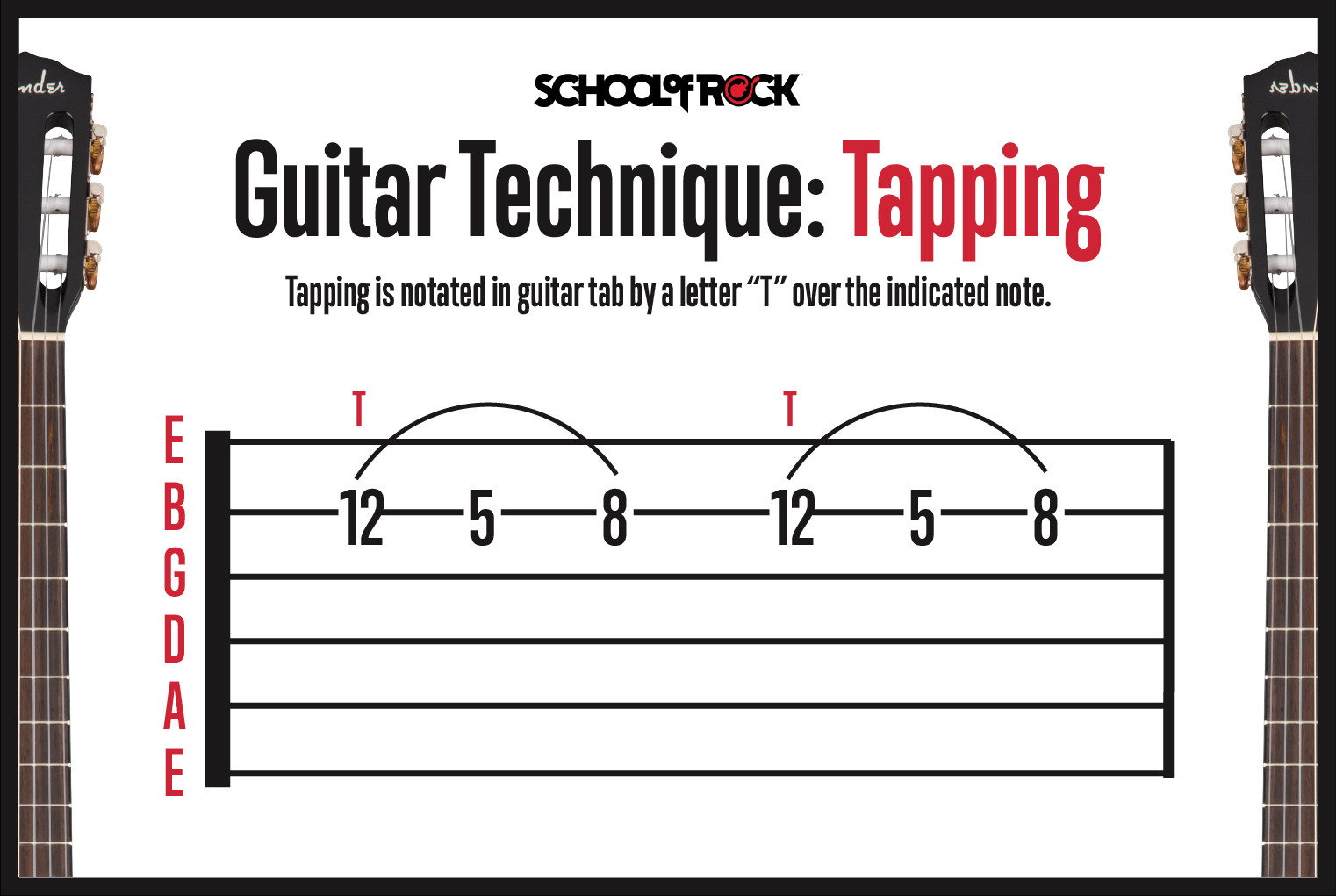 Guitar Tapping Technique
Guitar Tapping Technique
Guitar Technique: Two-Handed Tapping
Two-handed tapping takes the technique further by enabling both hands to play independently on the fretboard without traditional picking. Both fretting and picking hands are used to hammer-on notes. This can be used to play bass lines with the fretting hand while simultaneously tapping melodies or solos with the picking hand, creating complex textures.
Strumming Guitar Notes: Rhythmic Chord Playing
Strumming is fundamental to rhythm guitar playing, particularly when playing chords. Strumming involves two basic stroke types: downstrokes and upstrokes.
Downstrokes are played from the lower (bass) strings towards the higher (treble) strings in a downward motion. In guitar tabs on guitar, downstrokes are represented by a symbol resembling a thick horizontal line with two short “legs” pointing downwards on either side.
Upstrokes are the opposite, played from the higher strings towards the lower strings in an upward motion. In guitar tabs, upstrokes are indicated by a “V” shaped symbol.
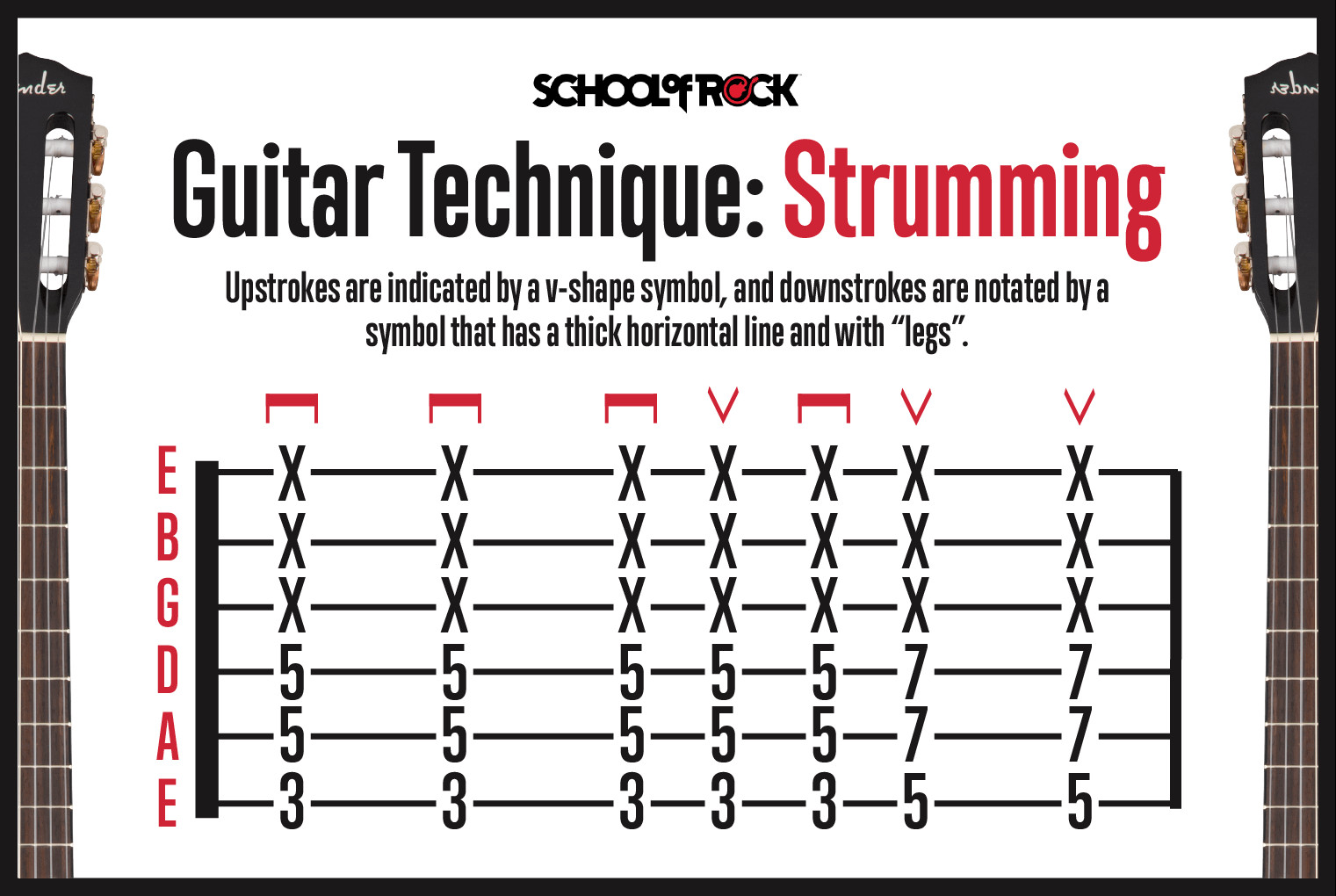 Guitar Strumming Technique Symbols
Guitar Strumming Technique Symbols
How to Strum Guitar Chords Rhythmically
When strumming chords, various strumming patterns are used to create different rhythms. You can use a simple constant downstroke pattern, an alternating downstroke-upstroke pattern, or more complex combinations. For songs in 4/4 time with eighth-note rhythms, you often count “one and two and three and four and.” Many songs utilize alternating downstrokes on the numbered beats (1, 2, 3, 4) and upstrokes on the “ands.”
Guitar Technique: Downstrokes and Upstrokes for Single Notes
The same downstroke and upstroke notation applies to single notes in guitar tabs on guitar. Downstrokes (horizontal bar with legs) indicate picking the note with a downward motion of your pick, while upstrokes (V symbol) indicate picking with an upward motion.
Ready to Explore More Guitar Techniques?
Now that you’ve learned how to read guitar tabs on guitar and understand common guitar techniques, you’re equipped to start playing a vast repertoire of music. From beginner-friendly songs to advanced compositions, guitarplayers.net is here to support your musical journey. Our comprehensive resources and expert guidance will help you master techniques from basic strumming to advanced tapping, enabling you to play your favorite songs and reach your full potential.
Eager to find guitar tabs to play? From easy beginner songs to challenging pieces for experienced players, guitarplayers.net has you covered. Explore our curated selection of high-quality guitar tabs and sheet music to start playing today!
Thinking about a new guitar? Check out our Comprehensive Guitar Buying Guide!

